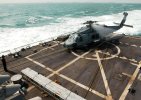When the Navy bought the H-60B, they moved the tailwheel up so there'd be more room on the smaller deck. A few years later, the Navy bought the H-60F and the Reserves bought the initial batch of H-60H's (which active Navy soon bought into). Since they were being built on the same production line that did the H-60B, the tailwheel stayed forward for interoperability.
When the Navy was looking to replace the H-46, there were two choices, a new 'tandem rotor' helo or a 'blackhawk varient'. Since the Army cancelled the order of 120+ H-60L to move funding for the Comanchee (which later got killed as well) Sikorsky had a bunch of airframes partially assembled that they offered to the Navy for a reduced price. This resulted in the Navy being able to replace every H-46 on the flight line with a H-60 varient for the same price it was going to take to develope a single prototype of a tandem rotor helo. (Boeing sold the production rights to the Sea Knight to Kawasaki, where you can now buy a brand new H-46 if you want...)
The Navy wanted to move the tail in, but the price tag was going to be $1 million per airframe to move it. (Lots of structural work needed to done on the inside since the airframe structure of an H-60S and all other USN H-60's is VERY different.
So, the Navy did the cheaper option and we now have the tailwhere in the rear like an Army blackhawk.
Since the H-60R is a new airframe and is designed to deploy on CRU/DES ships, it has the smaller footprint.
Probably more than you wanted to know, but that's why it is what it is.
When the Navy was looking to replace the H-46, there were two choices, a new 'tandem rotor' helo or a 'blackhawk varient'. Since the Army cancelled the order of 120+ H-60L to move funding for the Comanchee (which later got killed as well) Sikorsky had a bunch of airframes partially assembled that they offered to the Navy for a reduced price. This resulted in the Navy being able to replace every H-46 on the flight line with a H-60 varient for the same price it was going to take to develope a single prototype of a tandem rotor helo. (Boeing sold the production rights to the Sea Knight to Kawasaki, where you can now buy a brand new H-46 if you want...)
The Navy wanted to move the tail in, but the price tag was going to be $1 million per airframe to move it. (Lots of structural work needed to done on the inside since the airframe structure of an H-60S and all other USN H-60's is VERY different.
So, the Navy did the cheaper option and we now have the tailwhere in the rear like an Army blackhawk.
Since the H-60R is a new airframe and is designed to deploy on CRU/DES ships, it has the smaller footprint.
Probably more than you wanted to know, but that's why it is what it is.


